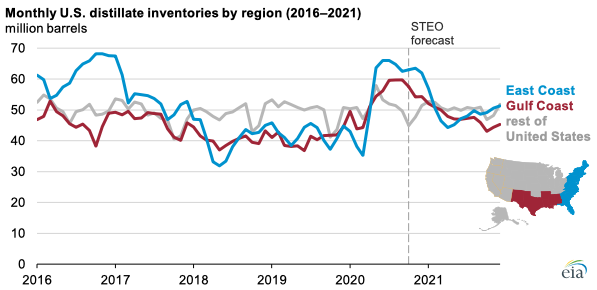EIA expects relatively high distillate inventories to decrease through the winter
Oct 20, 2020U.S. distillate fuel oil inventories remained high through summer 2020 because production outpaced demand. The U.S. Energy Information Administration (EIA) expects that increased demand for distillate fuel oil in the agriculture and residential sectors in the coming winter will help to draw down high U.S. distillate inventories. These initially relatively high inventories, along with lower crude oil prices, will continue putting downward pressure on distillate fuel oil prices through the 2020–21 winter season.

In March, U.S. refiners reduced their production as the effects of pandemic-related measures decreased demand for transportation fuels. Demand fell faster than supply, leading to large and rapid increases in petroleum product inventories, especially for distillate fuel oil.
Weekly U.S. distillate inventories peaked at 180 million barrels near the end of July, which was the largest inventory recorded since December 1982, according to data in EIA’s Weekly Petroleum Status Report. Distillate inventories have since declined to 165 million barrels, as of October 9, but are still higher than the five-year average for this time of year.
Most U.S. distillate inventories are located in the East Coast and Gulf Coast regions. The East Coast is the largest source of petroleum product demand in the United States, but the region relies on pipelines from the Gulf Coast to meet regional demand. These two regions accounted for 65% of U.S. distillate fuel oil storage capacity as of March 2020.
U.S. distillate demand typically increases during the fall, when diesel-powered agricultural equipment is used to harvest crops. According to its latest forecast, the U.S. Department of Agriculture expects the 2020 harvest season for corn and soybeans (the largest U.S. crops in terms of acreage) to cover a wider area and to produce a higher yield per acre than in 2019.
In the United States, distillate demand typically remains elevated through the winter months; many homes, especially in the Northeast, use distillate as their primary space heating fuel. Based on temperature forecasts from the National Oceanic and Atmospheric Administration, EIA expects the 2020–21 winter to be colder than last winter, which was relatively mild, and slightly colder than the previous 10-winter average.
More information on distillate fuel markets this winter is available in EIA’s This Week in Petroleum.
Principal contributor: Kevin Hack
Similar Stories

LNG powers unprecedented year for orders of alternative-fueled vessels
View Article
Since the 2011 Fukushima accident, Japan has restarted 14 nuclear reactors
View Article
Shell starts production at Whale in the US Gulf of Mexico
View Article
European gas prices fall despite Norwegian outage - Rystad Energy’s Gas and LNG Market Update
View ArticleHycamite is getting ready for the next growth steps
A successful investment round completed with long-term equity commitments of high-quality investors
View Article
Alleima supplies Preem in the green transition of the aviation industry
View ArticleGet the most up-to-date trending news!
SubscribeIndustry updates and weekly newsletter direct to your inbox!





